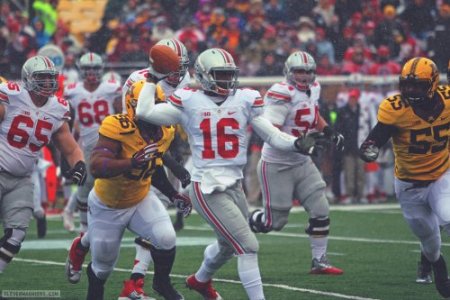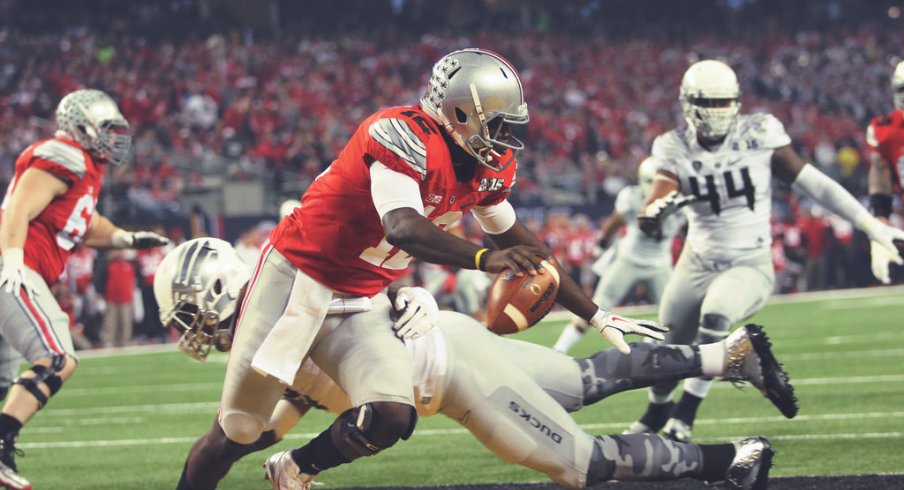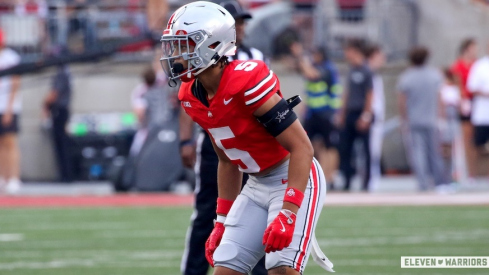Football may be a contact sport, but no offensive player likes being the recipient of a bone-crunching hit – least of all a quarterback.
When J.T. Barrett suffered a broken ankle against Michigan in November, he had to commit to a rigorous rehab program to be back to 95 percent health in July. Braxton Miller has endured several foot and labrum injuries since the 2014 Orange Bowl. Cardale Jones, while healthy, is a big target to defensive linemen who'd like nothing more than to turn him into a smear on the turf.
No matter who wins the quarterback derby, the Buckeyes need the starter to take fewer hits than Barrett and Jones did in 2014. There are a few ways they could do this.
The Buckeyes could structure their running game so that halfbacks, H-backs and receivers handle the ball more often, but as anyone who's watched a Meyer offense the quarterback will always be a frequent ballcarrier. Therefore, given Ohio State's offense, the best way to reduce the hits its quarterbacks take is to reduce their sack rate.
It's hard to perfectly measure the pressure a quarterback faces in a game. Quarterbacks are frequently hit or forced to hurry passes, but much of that pressure doesn't show up in the box score. Sacks do, and sack rate (sacks divided by sacks plus passing attempts) is the most common statistic to illustrate pressure.

In 2014, J.T. Barrett was sacked 23 times on 314 attempts, and Cardale Jones was sacked five times on 92 attempts. Combined, they were sacked 28 times on 434 passing attempts, a sack rate of 6.45 percent, 71st in the country. Adjusting for opponent strength, the Buckeyes finished 74th.
One might assume that more mobile quarterbacks are less likely to be sacked, but the opposite is true for Ohio State's signal callers.
Cardale Jones, who is more power-oriented, had the best sack rate at 5.2 percent. Barrett, who is somewhat nimble, was sacked 6.8 percent of the time. Braxton Miller, the quickest of the bunch, had a sack rate of 7.61 percent in 2013. All of them can improve their technique to withstand defensive pressure.
Miller's sack rate has improved each year as a starter, and if he gets the starting nod it'll be crucial for him to avoid hits. He has a tendency to pull the ball down and run, and his high sack rates come from defenders chasing him down. Staying in the pocket and trusting OSU's weapons will be the priority.
Although Barrett was frequently sacked, the sacks were arguably a tribute to his pocket presence. Barrett took his time scanning the field and going through progressions, and fought the freshman instinct to tuck the ball and run; when he did it was often for gains.
Without the Virginia Tech disaster, he would have been sacked 5.3 percent of the time – virtually identical to Jones. Still, he took hits he didn't need to, and if he wins the starting job he'll be expected to have the awareness to throw the ball away more often.
Cardale Jones fits the Ben Roethlisberger mold as a man-beast who is nearly impossible to bring down alone. When he was sacked, it was usually because he was ambushed in the pocket:
For Jones, if he wins the starting role, feeling out blitzes and immediate pressure ought to be one of his immediate concerns. If he can get outside the pocket, his powerful arm makes him a key threat.
All three's sack rates should be buoyed by a stronger offensive line. Ohio State's offensive line improved throughout 2014, and its returning starters should give the quarterback a larger margin of error.
Although the line should alleviate some of these concerns, Ohio State's quarterbacks should help by making smart decisions in the pocket and on the run. Their health is paramount to OSU's championship repeat hopes.


